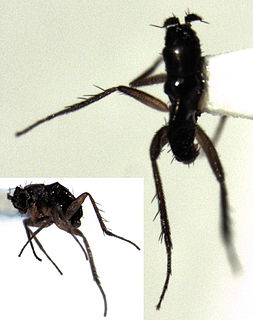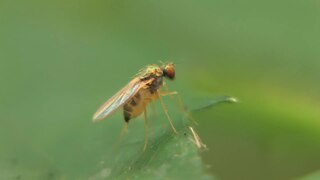| Haromyia | |
|---|---|
| Scientific classification | |
| Kingdom: | Animalia |
| Phylum: | Euarthropoda |
| Class: | Insecta |
| Order: | Diptera |
| Family: | Dolichopodidae |
| Subfamily: | incertae sedis |
| Genus: | Haromyia Runyon, 2015 [1] |
| Species: | H. iviei |
| Binomial name | |
| Haromyia iviei Runyon, 2015 [1] | |
Haromyia is a genus of flies in the family Dolichopodidae. It contains only one species, Haromyia iviei, known from Dominica. Flies in the genus and species have a small body size measuring between 1.0 to 1.5 mm in length, a bulging clypeus with six large setae, and wing veins that are nearly straight and evenly diverge from the base of the wing to the tip.

Flies are insects with a pair of functional wings for flight and a pair of vestigial hindwings called halteres for balance. They are classified as an order called Diptera, that name being derived from the Greek δι- di- "two", and πτερόν pteron "wings". The order Diptera is divided into two suborders, with about 110 families divided between them; the families contain an estimated 1,000,000 species, including the familiar housefly, horse-fly, crane fly, and hoverfly; although only about 125,000 species have a species description published. The earliest fly fossils found so far are from the Triassic, about 240 million years ago; phylogenetic analysis suggests that flies originated in the Permian, about 260 million years ago.

Dolichopodidae, the long-legged flies, are a large, cosmopolitan family of true flies with more than 7,000 described species in about 230 genera. The genus Dolichopus is the most speciose, with some 600 species.

Dominica, officially the Commonwealth of Dominica, is an island country in the West Indies. The capital, Roseau, is located on the western side of the island. It is part of the Windward Islands in the Lesser Antilles archipelago in the Caribbean Sea. The island is located near Guadeloupe to the northwest and Martinique to the south-southeast. Its area is 750 km2 (290 sq mi), and the highest point is Morne Diablotins, at 1,447 m (4,747 ft) in elevation. The population was 71,293 at the 2011 census. The Commonwealth of Dominica is one of the Caribbean's few republics.
The genus does not currently fit into any established subfamily, although it superficially resembles both the Enliniinae and Achalcinae.
Enliniinae is a subfamily of flies in the family Dolichopodidae.

Achalcinae is a subfamily of flies in the family Dolichopodidae.
The genus is named after the botanist and entomologist Harold E. Robinson, for his works on Dolichopodidae. The species is named after the coleopterist Dr. Michael Ivie, who provided the only known specimens of the species. [1]
Harold Ernest Robinson is an American botanist and an entomologist.





